#Leif Skoogfors
Text

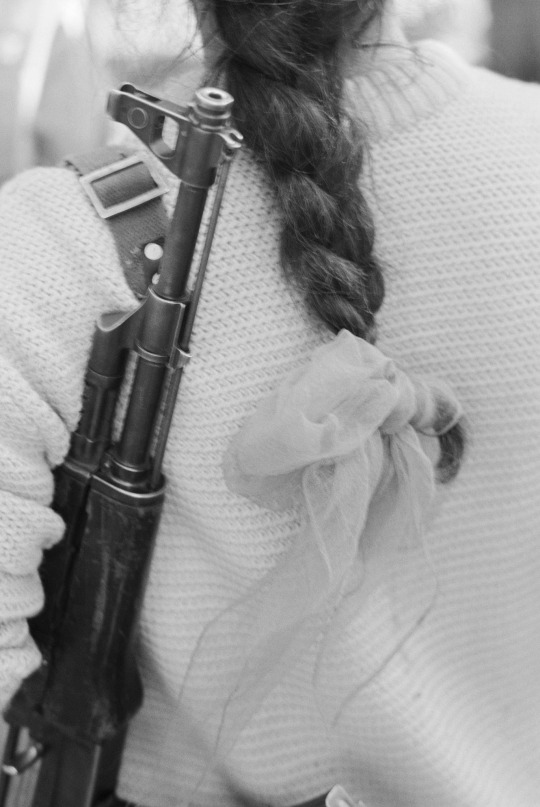
“Women at the Palestine Liberation Organization training camp learn with Al-Fatah. Location: Jordan.”
Photographed by Leif Skoogfors, 1968.
6K notes
·
View notes
Text
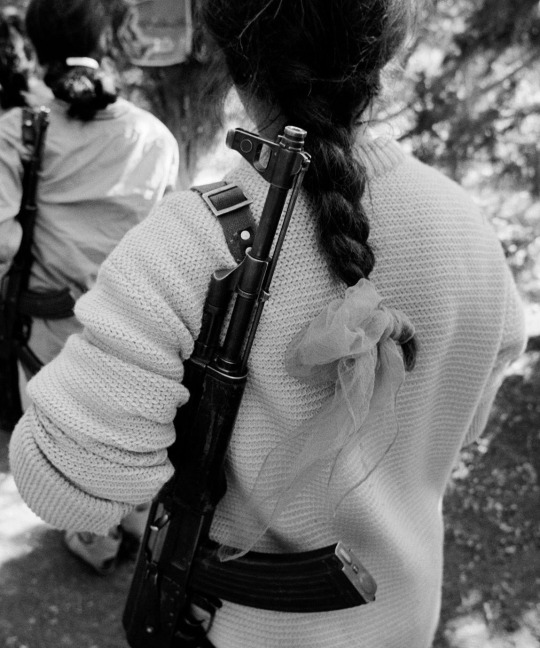
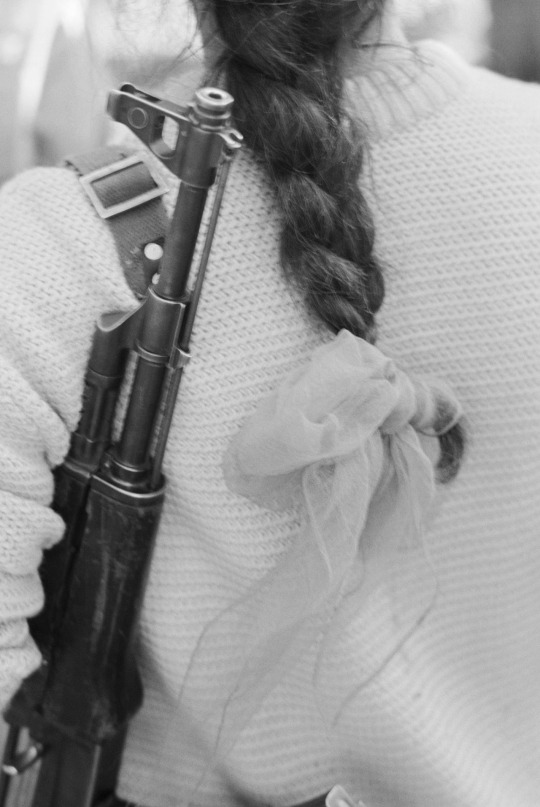
"Women at the Palestine Liberation Organization training camp learn with Al-Fatah. Location: Jordan."
Photographed by Leif Skoogfors (1968)
#palestine#jordan#liberation#photography#Leif Skoogfors#women#black and white#ak47#hair#braid#Al-Fatah#free palestine#free gaza#free palestine 🇵🇸#فلسطين 🇵🇸#🇵🇸#1968
980 notes
·
View notes
Photo

The Vietnam Veterans Against the War rally at Valley Forge National Park, Pennsylvania, September 7, 1970. Photo by Leif Skoogfors.
63 notes
·
View notes
Text
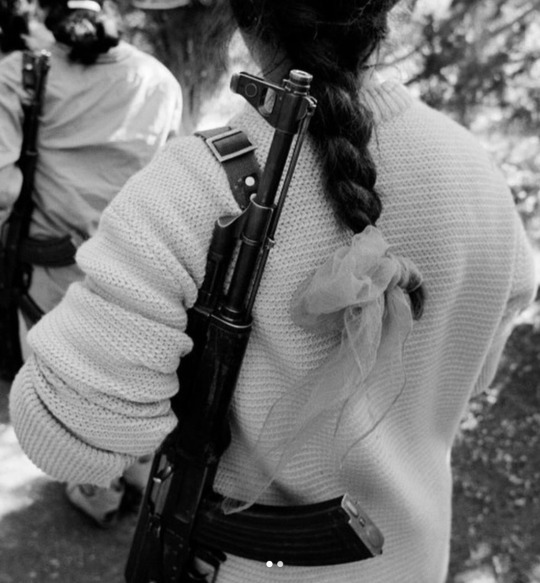

women at the palestinian training camp, jordan. photographed by leif skoogfors, 1968
8 notes
·
View notes
Photo

1975 - Patti Smith performs at a rally celebrating the fall of Saigon that ended the Vietnam War. (Photo by Leif Skoogfors)
92 notes
·
View notes
Photo

A Vietnam veteran with a flower in his gun attends an anti-Vietnam War rally at Valley Forge, Pennsylvania. Photo by Leif Skoogfors. 1970.
9 notes
·
View notes
Text

The Complex History Behind Belfast—and Its Echoes in Present-Day Northern Ireland
On Oct. 5, 1968, chaos broke out in the streets of Derry, Northern Ireland. As a civil rights parade wound through the streets, the police—or Royal Ulster Constabulary (RUC)—blocked the protesters’ route, surrounding them. Forming two intimidating lines on either side, the RUC baton-charged protesters. Images of the violence were broadcast into homes around the globe. Writing later that month for the BBC magazine, The Listener, the poet Seamus Heaney declared the moment a “watershed in the political life of Northern Ireland.” After this, Heaney wrote, there could be no more “shades of grey.”
I thought of Heaney’s words as I watched Kenneth Branagh’s heavily autobiographical film Belfast, which releases in the U.S. on Nov. 12 following a successful run at fall film festivals. The film opens with glorious vistas of contemporary Belfast in full color, from its opening shot of the sunflower yellow of the Harland and Wolff cranes to the lilac sea-blues of the Titanic museum, and aerial footage of the city surrounded by the verdant green of Cave Hill, nestled in the crook of Belfast Loch. A version of Van Morrison’s “Coming Down to Joy” soundtracks these images. We only get a glancing look at this highlight of the city’s tourist reel before we soon lose the pigment for black and white Belfast of mid-August 1969.
At first, the movie presents this moment in the city’s history as a more innocent time. We see the lead character, a young boy named Buddy (Jude Hill), playing with his friends in their terraced street in a “mixed” area of north Belfast, where both of Northern Ireland’s dominant two communities live alongside each other peacefully. These “two communities” have their roots in centuries of entanglements between Ireland and Britain, an often-fraught relationship exacerbated exponentially by the messy, violent partition of Ireland in 1921. The “two sides” are the nationalist or republican community, who are usually (but not always) Catholic and identify as Irish; and the unionist or loyalist community, largely Protestant, who identify as British and wish to remain in “the union” that forms the United Kingdom of Northern Ireland and Great Britain.
In Branagh’s Belfast, this peace between communities doesn’t last for long. Minutes into the film, a wide-eyed Buddy is confronted with a riotous, swarming masked mob brandishing torches and homemade weapons, screaming chants of “Catholics Out!” It’s a pacey opening scene. But, for all the exposition-heavy dialogue that follows (“You’re as welcome here as anyone, Paddy”) and the occasional splices of TV or radio news playing in the background, audiences unfamiliar with the Northern Ireland conflict might be left as disoriented and confused as Buddy is.
A summer of escalating violence

Two young girls stand with members of the British Army's Parachute Regiment in the primarily Catholic Divis Flats housing estate, Belfast, Northern, Ireland, August 10, 1969 Leif Skoogfors/Corbis via Getty Images
The riots that Buddy witnesses did in fact happen in Belfast in August 1969, and Branagh’s film draws strongly on his own experience as a child growing up at 96 Mountcollyer Street in north Belfast. The writer-director, whose family was Protestant, has said that he hid under the dining room table, much like Buddy and his older brother’s mother instructs them to do, as a group of Protestants from the Shankill Road came to their street with the aim of intimidating Catholics out of their homes.
The riots came as part of a week of violence across Northern Ireland. On Aug. 12, in Derry, a parade by the Protestant Apprentice Boys was followed by fighting between the RUC and the residents of the Bogside, a Catholic nationalist area of the city. The British Army was deployed to quell what is now known as the “Battle of the Bogside.” In Belfast, and across the North, nationalists called for protests in response; amid the escalating tensions and paranoia across the city, violent riots soon broke out.
Until this point, parts of Belfast had still been relatively mixed, with Catholics and Protestants often living side by side. As the violence escalated, many families fled their homes in terror; scores of houses were burnt down, like those in Conway and Bombay Streets in west Belfast. This was displacement on a significant scale: thousands of people left their homes, with many Catholic refugees fleeing south across the border in an echo of the unrest following Partition. This decision—to stay or to leave and start a new life in England—is the central tension facing Buddy’s family in the film, with his parents, whom he calls Ma (Catriona Balfe) and Da (Jamie Dornan), in a stalemate.

Jamie Dornan and Caitriona Balfe play young parents deciding whether to stay or go as violence escalates in Belfast in 1969 Rob Youngson / Focus Features—© 2021 Focus Features, LLC.
Makeshift barricades went up across the city, as depicted in Belfast. There was an unease among the Catholic population that the police would not protect them and their homes because the RUC was overwhelmingly unionist and Protestant. Branagh’s film gives voice to this fear of abandonment, too, when one of the characters declares, “The Police won’t protect us, we have to do it ourselves.” While Buddy’s family is Protestant, his father faces threats of violence from another Protestant character for his attempts to remain neutral—his insistence on remaining in the “shades of grey.”
As Branagh’s film also dramatizes, the British Army was sent into the streets of Belfast that month. Initially deployed as a temporary measure to protect Catholics from violence, the British Army’s “Operation Banner” would maintain a presence that became tense in Northern Ireland from 1969 until 2007, nearly a decade after the Good Friday/Belfast Agreement brokered a fragile peace.
Part of a global movement for civil rights
These riots of 1969 didn’t come out of nowhere: tensions had been building for years. In Belfast, Buddy’s Da lays the blame for the conflict at the feet of “Bloody Religion;” this is an oversimplification of a highly complex political situation. The violence of Partition had established a statelet with a Protestant majority; unionist interests were maintained through repressive tactics to the detriment of the Catholic minority. Being Catholic didn’t just mean that you held different religious beliefs: it meant you were significantly more likely to suffer unfair employment practices, inequitable housing distribution and be disenfranchised due to gerrymandering that favored unionists in elections.
Unrest had been especially potent following the establishment of the Northern Ireland Civil Rights Association (NICRA) in 1967. The NICRA was founded in an effort to address state discrimination against the Catholic minority and members came from a variety of political and religious backgrounds. And, of course, Ireland didn’t exist in a vacuum. Social activism, civil rights mobilization and mass protest were a globally defining feature of the late 1960s.
This Northern Irish civil rights movement drew heavily on the U.S.-based African-American civil rights movement of the 1960s for inspiration. In 1969, Irish politician and civil rights campaigner Bernadette Devlin was given the key to New York City; in 1970, on his visit to the United States, fellow Irish activist Eamonn McCann gave this key to the Black Panthers “as a gesture of solidarity with the Black liberation and revolutionary socialist movements in America.”
Branagh’s film gives us glimpses of this Belfast, too. It’s a Belfast that is much more diverse than viewers might expect, and one that complicates the idea that Belfast’s social fabric consists only of the binary “two communities.” Buddy’s schoolteacher is played by Irish-Nigerian actor Vanessa Ifediora, and there are numerous South Asian families living in north Belfast, including Mr Singh, who runs their local corner shop, and Granny’s (Judi Dench) Indian neighbor.
The Belfast writer Glenn Patterson has stated that “Belfast in the mid-1960s is curiously a very outward looking place.” In his novel The International (1999), about a barman in Belfast’s International Hotel in 1967, Patterson reaches back to a moment just before violence engulfed Northern Ireland. Like Branagh’s Belfast, returning to this time of suspended animation before the horror of the Troubles is a powerful way to retell the history of the conflict. It allows Branagh, who emigrated to England with his parents in 1970, to indulge in the romantic nostalgia of his own memory, and there is something highly artificial in the stylized aesthetic of the film. The carefully composed scenes remind viewers of the theater or old Hollywood, both of which, during a few scenes when the family enjoys a cultural outing together, puncture the narrative with bursts of color.
The child’s perspective as a storytelling device

Judi Dench (left) and Ciarán Hinds (right) play the beloved grandparents of Jude Hill's Buddy in Kenneth Branagh's 'Belfast' Rob Youngson—© 2021 Focus Features, LLC.
But this return to an earlier Belfast does more than this. Telling audiences about how close these Belfast communities were, as neighbors chat on doorsteps and run through each other’s houses, makes plain how terrifying—and heartbreaking—the looming civil war will be. An amusing scene where Buddy and his friend, Moira (Lara McDonnell), discuss whether their names reveal their religious identity makes light of what would come. To return to Heaney once more, his caution that you must be “expertly civil-tongued with civil neighbours” rings heavy here. Branagh’s vision of such friendly coexistence foreshadows the horrifying intimacy of the impending conflict marked, Heaney writes, by “neighbourly murder.”
There’s also something painfully resonant about the film’s focus on the North through the eyes of a young child, even if Branagh runs the risk of simplifying or decontextualizing the very real history against which the story of Belfast is set. The Irish boyhood narrative has some serious literary clout to it too, like James Joyce’s Portrait of the Artist as a Young Man (1916)—to which Branagh’s film makes some decided nods, notably through the lengthy sermon from Buddy’s Protestant minister (in contrast to Joyce’s Catholic priest) about the horrors of hell awaiting sinners.
Using a child’s perspective to frame narratives about the North is common, too, as readers or viewers gain awareness and understanding of the conflict as the lead character does. Seamus Deane’s autobiographical novel Reading in the Dark (1996) springs to mind here, as does Lucy Caldwell’s novel Where They Were Missed (2006). Caldwell’s work is part of a growing body of fiction insisting on the importance of the Irish girlhood; Lisa McGee’s irreverent TV series Derry Girls is another joyful example.
Some of the drama of Belfast rests on the all too real fears of Buddy’s parents that their teenage son, Will, might be pressured into joining a loyalist gang. Children did become co-opted into various paramilitary organizations during the conflict. They were also casualties, too, as the harrowing ground of Freya McClements and Joe Duffy’s Children of the Troubles: The Untold Story of the Children Killed in the Northern Ireland Conflict makes so painfully clear.
A subtle—and contemporary—politics
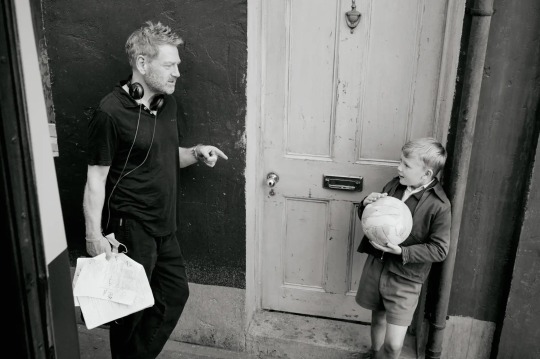
Director Kenneth Branagh (left) and actor Jude Hill (right) on the set of 'Belfast' Rob Youngson / Focus Features—© 2021 Focus Features, LLC.
Though Branagh’s film looks to be on solid footing heading into a long awards season, its saccharine charm won’t please everyone. Some reviewers have been quick to suggest it is apolitical—presumably because there are no men in suits debating things; no explicit references to paramilitary organisations; no discussion about “union,” either Irish or British. Belfast might not be Political in the way we demand of material about the Northern Ireland conflict, but it has its own politics, despite its simplified retelling of the conflict’s tensions. It’s the politics of the everyday, the personal and the ordinary. In small, subtle ways, Branagh’s film shows how homes, families and lives were lost and irrevocably changed by the conflict. Dustbin lids become makeshift shields; milk bottles become petrol bombs; laundry detergent is the centrepiece of a riot; doors close on relatives that would not open again.
For those who live in Northern Ireland, the simple facts of daily life are political. You can see this in the endless debate about what to call the six county statelet. Branagh’s film gets its release in the same year as the centenary of the Partition of Ireland, marking 100 years of a divided island. People who live in the North live with shades of gray, despite the fact that our political system operates on a consociational model which insists on binary thinking. This means all political decisions come back down to the black and white of Catholic/Protestant, nationalist/unionist.
The night I watched Belfast, a protest, ostensibly about dissatisfaction with the new Brexit protocol, broke out in Lanark Way, an interface area between communities in west Belfast. Alongside one of Belfast’s euphemistically named “Peace Walls,” loyalist youths threw missiles and fireworks at the police. The police made two arrests: both were boys, one 12, the other 15. Branagh’s black and white ode to a disappeared Belfast might play to most audiences as a historical drama. But as Northern Ireland hits the headlines again, for all the wrong reasons, Belfast might be more of a contemporary story than reminiscence on the long lost past.
Dr Alison Garden is a writer and academic based at Queen’s University Belfast, and the author of The Literary Afterlives of Roger Casement, 1899-2016 (2020). She is currently writing a book about love, mixed marriage and the Northern Ireland Conflict. She tweets at @NotSecretGarden and you can learn more about her work here.
Remember… telling audiences about how close these Belfast communities were, as neighbours chat on doorsteps and run through each other’s houses, makes plain how terrifying—and heartbreaking—the looming civil war will be. — Time
#Tait rhymes with hat#Good times#BelfastMovie#History#The Troubles#Northern Ireland#Time#11 November 2021#Belfast#Worldwide 2022#Twitter
8 notes
·
View notes
Audio

2020 presidential candidate and Massachusetts Senator Elizabeth Warren was first mentioned by NPR in 1991, when she was interviewed on All Things Considered for a story about people filing for bankruptcy during the economic recession. At the time, Warren was a professor at the University of Pennsylvania and co-author of one the largest studies ever done on bankruptcy.
"We have to rebuild our infrastructure to deal with climate change that is bearing down upon us. The urgency of the moment on climate change cannot be overstated. It's upon us and we need to make change and make change fast.”
-Elizabeth Warren, from Morning Edition's Election 2020: Opening Arguments series.
Photo: American academic (and future US Senator) Professor Elizabeth Warren teaches a class at University of Pennsylvania Law School, Philadelphia, Pennsylvania, early 1990s. NPR first mentioned Warren in 1991.
Credit: Photo by Leif Skoogfors/Corbis via Getty Images
Posted by Evelyne Zapata, NPR RAD intern
#first mention#Elizabeth Warren#Presidential Candidates#election 2020#morning edition#opening arguments#women’s history#NPR#NPRrad#nprchives#all things considered
322 notes
·
View notes
Photo

✊🏿📷 #ArtIsAWeapon #NeverForget 1978 #photo of #MOVE members in #Philadelphia by #photographer #educator #LeifSkoogfors. Reposted from @mocada_museum - On May 13, 1985, the Osage Avenue headquarters (and communal home to many) of the black liberation group MOVE was bombed by Philadelphia police. The direct attack began long before an FBI-grade dynamite substitute was airdropped onto the roof of the house (The first attack actually happened years prior in 1978 which forced MOVE members to leave their former West Philadelphia home into this one). Earlier that day, more than 500 police officers released 10,000 rounds of ammunition and tear gas into the home and used high-pressure fire hoses to counteract "alleged" gunfire they say came from within the rowhouse on the 6200 block. And when the group refused to surrender, then Commissioner Sambor ordered the bombing, which spread quickly through the surrounding homes, killing 6 adult MOVE members, five children, and destroyed 65 houses in the neighborhood. Today we remember the members of MOVE, and their staunch #advocacy for our #liberation and reconnection to #nature, while rejecting materialism and anything that would lead us astray. 📷: MOVE members in front of their original headquarters in the Powelton Village area of Philadelphia in 1978. Photo by. LEIF SKOOGFORS/CORBIS ✊🏾👊🏾✊🏿 #ThisIsAmerica #MOVEPhiladelphia #AmericanHistory #StateSanctionedTerrorism #socialjustice #blackliberation #policeviolence #TraScapades #ArtIsAWeapon https://www.instagram.com/p/BxfHjjWhmZK/?igshid=15tbsjxvaz52n
#artisaweapon#neverforget#photo#move#philadelphia#photographer#educator#leifskoogfors#advocacy#liberation#nature#thisisamerica#movephiladelphia#americanhistory#statesanctionedterrorism#socialjustice#blackliberation#policeviolence#trascapades
0 notes
Photo

1991, North Carolina, USA --- A United States Army Special Forces member wears a face scarf and desert camouflage and carries a squad automatic weapon (SAW). --- Image by Leif Skoogfors/CORBIS
34 notes
·
View notes
Photo
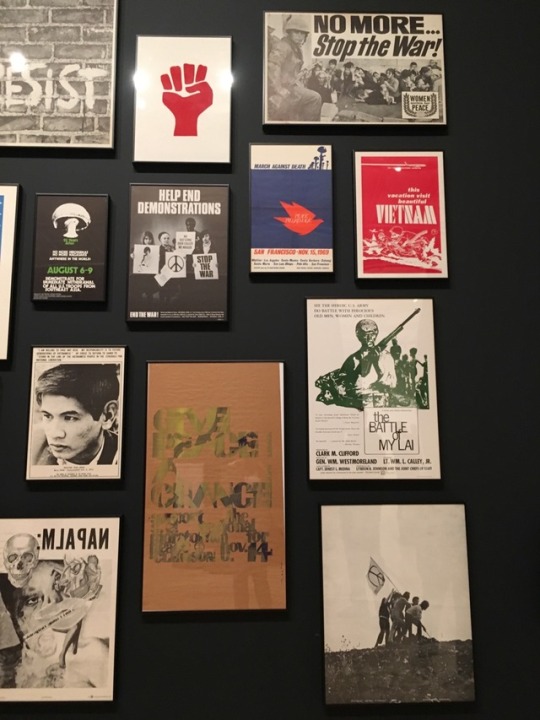
Installation view of An Incomplete History of Protest: Selections from the Whitney’s Collection, 1940–2017 (Whitney Museum of American Art, New York, August 18, 2017–). From left to right, top to bottom: Edward Kienholz, The Non War Memorial, 1970; Student Mobilization Committee to End the War in Vietnam, Hell No We Won’t Go, c.1969; Unidentified artist, Unite, c.1965-70; Women Strike for Peace, Stop the War, c.1967-70; Leif Skoogfors, John Kerry, 1971; Pro-Arts, Inc., Your Tax Dollars at Work, 1969; Janos Dannavitz, The War Makes Me Sick, 1967; New Mobilization Committee to End the War in Vietnam, No Christmas-as-usual, c.1971; Students for a Democratic Society, Come to Detroit Nov. 3, Elections are a Hoax…, 1970; Unidentified artist, Tin soldiers and Nixon coming… (Kent State), 1971; Yoko Ono and John Lennon, War is Over! If You Want It, 1969; International Union of Students, Stop U.S. Dirty War in Viet Nam, 1966; Lambert Studios, Inc., War Is Good Business, Invest Your Son, 1969; Unidentified artist, The United States government must end its systematic oppressions of political dissidents…, 1970; Brian Shannon, …But You Can’t Fool All of the People All the Time, 1971; Napalm Graphics, Johnson Pull Out Like Your Father Should Have, 1967; Kiyoshi Kuroyima, Fuck the Draft, 1968; Vietnam Peace Parade Committee, They can do anything we let them get away with…, 1971; Unidentified artist, Cambodia Too?, 1970; Tom Lafferty and Ken Deardoff, War is Hell! As the Man Who Fought One, 1968; Antioch Bookplate Co., Help Free America from Our Tragic Involvement in Vietnam, 1969; Clergy and Laymen Concerned, Is This What You’d Call “Phased Withdrawal?”, 1972; Vietnam Referendum ’70 Committee, Let the People Vote on War!, 1970; Michael Lynne, Give a Damn, Mend America, 1968; Robert L. Ross, Eat Me, 1967; Pro-Arts, Inc., Peace Needs No Excuse, 1970; Women Strike for Peace, Stop Bombing, c.1967-70; Richard Avedon and Marvin Israel, Who Has a Better Right to Oppose the War?, 1969; Gross National Product, Resist, 1968; Unidentified artist, Untitled, 1970; Women Strike for Peace, No More…Stop the War!, c.1967-70; Student Mobilization Committee to End the War in Vietnam, Would You Buy a Used WAR from This Man?, 1969; New Mobilization Committee to End the War in Vietnam, Rich Man’s War, the People Pay, 1967; Northern California Peace Action Coalition, March & Rally against the War…, c.1960-70; Irving White, Our foreign policy must always be an extension of this nation’s domestic policy…, 1968; Atomic Energy Group, “The streets of our country are in turmoil…”, 1970; A. Lunsford, “Those who have had a chance for four years…”, 1972; Robert Owen Bastian, Untitled, c.1965-70; National Peace Action Coalition, 25 Years After, 1970; Unidentified artist, Help End Demonstrations, 1968; Unidentified artist, March against Death, Peace Pilgrimage, San Francisco, Nov. 15, 1969, 1969; Pandora Productions, The Vacation Visit Beautiful Vietnam, 1966; United Women’s Contingent, “When Women Decide This War Should End, This War Will End”, 1971; Student Mobilization Committee to End the War in Vietnam, Out of S.E. Asia Now! Join the SMC, 1969; Student Mobilization Committee to End the War in Vietnam, U.S. out of Vietnam Now! Bring All the GI’s Home Now, 1970; The Union of Vietnamese in the United States, Nguyen Thai-Binh. Born: 1948—Assassinated: July 2, 1972, c.1972; Unidentified artist, Give Peace a Chance, 1969; Unidentified artist, The Battle of My Lai, 1971; Unidentified artist, “Never think that war, no matter how necessary nor how justified, is not a crime…”, 1970; Don Peterson, Untitled (Toronto), 1968; Student Mobilization Committee to End the War in Vietnam, “We are 1,366 active-duty servicemen. We are opposed to the American involvement in the war in Vietnam…”, 1969; Unidentified artist, Save Lives, Not Face, 1967; Unidentified artist, Cry Freedom, 1967; Women Strike for Peace, End the Draft!, c.1967-70; Sigmund Abeles, Vietnam Summer 1967, 1967; Vietnam Day Committee, University of California, Berkeley, Rock & Roll Benefit Dance…The Jefferson Airplane, 1966; William Weege, Napalm, 1967; Greg Daily, Peace Victory, 1971; Mierle Laderman Ukeles, I Make Maintenance Art One Hour Every Day, September 16-October 20, 1976. Photograph by Ron Amstutz
1 note
·
View note
Text
Was Diane Arbus the Most Radical Photographer of the 20th Century?
Was Diane Arbus the Most Radical Photographer of the 20th Century?
If you have ever seen a Diane Arbus photograph you will remember it, and her very personal style. That can only be said about few photographers. Thank you Leif Skoogfors for sharing this interesting article.
© Diane Arbus
A new biography and Met exhibit show how she sacrificed her marriage, her friendships, and eventually her life for her career as an…
View On WordPress
#Art photography#Creativity#experience#Fantasy#history#Life#memories#personal#Photographers#photography#Production#Reading#Recommendations#The world#Thoughts#Tips
0 notes
Photo

Photo by Leif Skoogfors (1971)
84 notes
·
View notes
Photo


Agnetha Fältskog at her Stockholm home in July 1977. Photos by Leif Skoogfors
311 notes
·
View notes